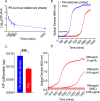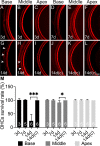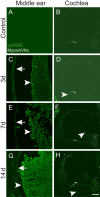Chronic suppurative otitis media causes macrophage-associated sensorineural hearing loss
- PMID: 36096817
- PMCID: PMC9465898
- DOI: 10.1186/s12974-022-02585-w
Chronic suppurative otitis media causes macrophage-associated sensorineural hearing loss
Abstract
Background: Chronic suppurative otitis media (CSOM) is the most common cause of permanent hearing loss in children in the developing world. A large component of the permanent hearing loss is sensory in nature and our understanding of the mechanism of this has so far been limited to post-mortem human specimens or acute infection models that are not representative of human CSOM. In this report, we assess cochlear injury in a validated Pseudomonas aeruginosa (PA) CSOM mouse model.
Methods: We generated persisters (PCs) and inoculated them into the mouse middle ear cavity. We tracked infection with IVIS and detected PA using RT-PCR. We assessed cochlear damage and innate immunity by Immunohistochemistry. Finally, we evaluated cytokines with multiplex assay and quantitative real-time PCR.
Results: We observed outer hair cell (OHC) loss predominantly in the basal turn of the cochlear at 14 days after bacterial inoculation. Macrophages, not neutrophils are the major immune cells in the cochlea in CSOM displaying increased numbers and a distribution correlated with the observed cochlear injury. The progression of the morphological changes suggests a transition from monocytes into tissue macrophages following infection. We also show that PA do not enter the cochlea and live bacteria are required for cochlear injury. We characterized cytokine activity in the CSOM cochlea.
Conclusions: Taken together, this data shows a critical role for macrophages in CSOM-mediated sensorineural hearing loss (SNHL).
Keywords: CSOM; Cytokines; HC loss; Macrophages; PA; SNHL.
© 2022. The Author(s).
Conflict of interest statement
The authors declare no relevant conflicts of interest.
Figures







Similar articles
-
Influence of CX3CR1 Deletion on Cochlear Hair Cell Survival and Macrophage Expression in Chronic Suppurative Otitis Media.Otol Neurotol. 2023 Jul 1;44(6):605-610. doi: 10.1097/MAO.0000000000003884. Otol Neurotol. 2023. PMID: 37315234 Free PMC article.
-
Targeting the NLRP3 inflammasome in cochlear macrophages protects against hearing loss in chronic suppurative otitis media.J Neuroinflammation. 2024 Sep 14;21(1):223. doi: 10.1186/s12974-024-03212-6. J Neuroinflammation. 2024. PMID: 39277762 Free PMC article.
-
Chemokine Receptor CCR2 Is Protective toward Outer Hair Cells in Chronic Suppurative Otitis Media.Immunohorizons. 2024 Sep 1;8(9):688-694. doi: 10.4049/immunohorizons.2400064. Immunohorizons. 2024. PMID: 39264736 Free PMC article.
-
Current concepts in the pathogenesis and treatment of chronic suppurative otitis media.J Med Microbiol. 2015 Oct;64(10):1103-1116. doi: 10.1099/jmm.0.000155. Epub 2015 Aug 5. J Med Microbiol. 2015. PMID: 26248613 Free PMC article. Review.
-
Mapping of audiometric analysis with microbiological findings in patients with chronic suppurative otitis media (CSOM): a neglected clinical manifestation.Crit Rev Clin Lab Sci. 2023 May;60(3):212-232. doi: 10.1080/10408363.2022.2158173. Epub 2023 Jan 5. Crit Rev Clin Lab Sci. 2023. PMID: 36604829 Review.
Cited by
-
Relationship Between Cochlear Lateral Wall Changes and Endolymphatic Hydrops in Otitis Media.Laryngoscope. 2024 Dec;134(12):5103-5108. doi: 10.1002/lary.31626. Epub 2024 Jul 3. Laryngoscope. 2024. PMID: 38958129
-
An automatic diagnosis model of otitis media with high accuracy rate using transfer learning.Front Mol Biosci. 2024 Mar 21;10:1250596. doi: 10.3389/fmolb.2023.1250596. eCollection 2023. Front Mol Biosci. 2024. PMID: 38577506 Free PMC article.
-
Analysis of the Clinical Symptom Improvement and Recurrence Rate in Chronic Suppurative Otitis Media Patients Treated with Combination Therapy: Combination of Ofloxacin and Dexamethasone.Risk Manag Healthc Policy. 2025 Jul 4;18:2275-2285. doi: 10.2147/RMHP.S520505. eCollection 2025. Risk Manag Healthc Policy. 2025. PMID: 40630217 Free PMC article.
-
VDAC1 Inhibition Protects Against Noise-Induced Hearing Loss via the PINK1/Parkin Pathway.CNS Neurosci Ther. 2025 Apr;31(4):e70410. doi: 10.1111/cns.70410. CNS Neurosci Ther. 2025. PMID: 40285415 Free PMC article.
-
Host-Microbe Interactions in Healthy and CSOM-Affected Middle Ears.Microorganisms. 2025 Feb 5;13(2):339. doi: 10.3390/microorganisms13020339. Microorganisms. 2025. PMID: 40005706 Free PMC article.
References
-
- Santa Maria PL, Kaufman AC, Bacacao B, Thai A, Chen X, Xia A, et al. Topical Therapy Failure in Chronic Suppurative Otitis Media is Due to Persister Cells in Biofilms. Otol Neurotol. 2021. - PubMed
MeSH terms
LinkOut - more resources
Full Text Sources

